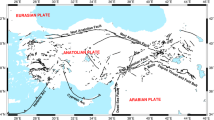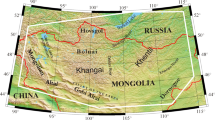Abstract
The structure of the vector field of present-day horizontal velocities on the Earth’s surface is investigated with the use of the territory covered by the Central-Asian GPS network as an example. A method of identification of groups of GPS points (statistically rigid clusters), for which the rate of change in distances between them is virtually zero, is proposed and realized. Sites of the Earth’s surface (regions) containing such groups of GPS points, within the required measurement accuracy, move in the horizontal plane as two-dimensional rigid bodies. The clustering algorithm, which is based on the Student t statistics in determining the so-called statistical “sample cost,” is developed and carefully tested. The results of identification of regions take into account possible random errors in velocity measurements and do not depend on the chosen frame of reference. The method of identification of regions is sufficiently stable with respect to variations in the number of GPS sites used for clustering. Of all the sites of the Central-Asian GPS network, 323 points were selected for clustering. These sites were measured from 3 to 11 times over an 11-year interval of observations (1995–2005). The estimates of errors of velocity measurement for these sites must not exceed 1.0 mm/yr. As a result, 29 statistically rigid clusters, containing from 3 to 17 GPS sites, were identified, and the kinematic regimes of motion of regions corresponding to these clusters were determined with respect to the stable part of Eurasia. With the general direction of the translatory motion of regions toward the north, the majority of them rotate counterclockwise. Nearly one third of GPS sites do not participate in the formation of clusters; these points fall into the interregional space (IRS), which is characterized by increased strain rates. The IRS structure is partitioned into zones with four directions, of which two directions virtually coincide with directions of the principal axes of the regional strain rate tensor, and the two other directions are oriented diagonally to the principal axes. The axis of the maximum rate of the regional shortening has a north-northwestern orientation. It is in this direction (mainly along the IRS) that the crust’s contraction takes place. There is no spatial correlation between IRS zones and geological faults; however, their angular distributions and the directions of strike-slips on them are interrelated. The resulting patterns of regional motions and IRS deformations consistently reflect the dynamic action of the Indian plate on the territory under investigation.
Similar content being viewed by others
References
K. Ye. Abdrakhmatov, S. A. Aldazhanov, B. H. Hager, et al., “Relatively Recent Constructions of the Tien Shan Inferred from GPS Measurements of Present-Day Crustal Deformation Rates,” Nature, No. 384, 350–353 (1996).
M. A. Aizerman, Classical Mechanics (Nauka, Moscow, 1974) [in Russian].
E. Argan, Tectonics of Asia (ONTI, Moscow, Leningrad, 1935).
J.-P. Avouac and P. Tapponnier, “Kinematic Model of Active Deformation in Central Asia,” Geophys. Res. Lett. 20, 895–898 (1993).
A. B. Bakirov and R. A. Maksumova, “Geodynamic Evolution of the Tien Shan Lithosphere,” Geol. Geofiz. 42(10), 1435–1443 (2001).
T. P. Belousov, S. F. Kurtasov, and Sh. A. Mukhamediev, Divisibility of the Earth Crust and Paleostresses in Seismically Active and Oil-production Regions (UIPE RAS, Moscow, 1997) [in Russian].
J. Bendat and A. Piersol, Random Data, Analysis and Measurement Procedures (Wiley, New York, 1986; Mir, Moscow, 1989).
R. F. Cheeney, Statistical Methods in Geology (George Allen and Unwin, London, 1983).
Q. Chen, J. T. Freymueller, Q, Wang, et al., “A Deforming Block Model for the Present-Day Tectonics of Tibet,” J. Geophys. Res. 109 (2004) B01403. doi: 10.1029/2002JB002151.
T. H. Cormen, C. E. Leiserson, R. L. Rivest, and C. Stein, Introduction to Algorithms: Second Edition (The Mit Press, Cambridge, 2001).
Documentation for the GAMIT GPS Analysis Software Release 9.9/EAPS, MIT (2001).
P. C. England and D. P. McKenzie, “A Thin Viscous Sheet Model for Continental Deformation,” Geophys. J. R. Astron. Soc. 70, 295–321 (1982).
P. England and P. Molnar, “Active Deformation of Asia: from Kinematics to dynamics,” Science 278, 647–650 (1997).
P. England and P. Molnar, “Late Quaternary to Decadal Velocity Fields in Asia,” J. Geophys. Res. 110 (2005). B12401. doi: 10.1029/2004JB003541.
L. M. Flesch, A. J. Haines, and W.E. Holt, “Dynamics of the India-Eurasia Collision Zone,” J. Geophys. Res. 106, 16.435–16.460 (2001).
R. G. Gordon and S. Stein, “Global Tectonics and Space Geodesy,” Science 256, 333–342 (1992).
M. G. Leonov, “Phanerozoic Geodynamic Regime of the Southern Tien Shan,” Geotektonika, 30(3), 31–53 (1996).
R. A. Maksumova, A. B. Dzhenchuraeva, and A. V. Berezanskii, “Structure and Evolution of the Kirgizian Tien Shan Nappe-Folded Orogen,” Geolog. Geofiz. 42(10) 1444–1452 (2001).
R. McCaffrey, “Block Kinematics of the Pacific-North America Plate Boundary in the Southwestern United States from Inversion of GPS, Seismological, and Geologic Data,” J. Geophys. Res. 110 (2005), B07401. doi: 10.1029/2004 JB003307.
B. Meade, “Present-Day Kinematics at the India-Asia Collision Zone,” Geology 35, 81–84 (2007). doi: 10.1130/G22924A.1.
P. Molnar and P. Tapponnier, “Cenozoic Tectonics of Asia: Effects of a Continental Collision,” Science 189, 419–426 (1975).
Sh. A. Mukhamediev, A. V. Zubovich, and S. I. Kuzikov, “Identification of Crustal Blocks Based on GPS Data,” Dokl. Earth Sciences, 408(4), 678–681 (2006).
Sh. A. Mukhamediev and S. I. Kuzikov, “Reflection of Three-Dimensional Motions of Crustal Blocks in the Field of Horizontal Velocities on the Surface, in General and Regional Problems of Tectonics and Geodynamics. Proc. XLI Tectonic Conference. Vol. 2 (GEOS, Moscow, 2008a), pp. 50–54 [in Russian].
Sh. A. Mukhamediev and S.I. Kuzikov, “On the Possibility of Revealing the Kinematics of 3D Rigid Blocks of the Crust from GPS Data at Different Heights of Stations,” in Geodynamics of Intracontinental Orogens and Geoecological Problems:Proc. of the 4th International Symposium, Bishkek, June 15–20, 2008 (NS RAN, 2008b), pp. 161–164 [in Russian].
Recent Geodynamics of Areas of Intracontinental Collision Mountain Building (Central Asia) Ed. V. I. Makarov, Nauchnyi Mir, Moscow, 2005) [in Russian].
A. Replumaz and P. Tapponier, “Reconstruction of the Deformed Collision Zone between India and Asia by Backward Motion of Lithospheric Blocks,” J. Geophys. Res. 108. 2285 (2003). doi: 10.1029/2001JB000661.
E. A. Rogozhin, Paleozoic Tectonics of the Western Part of the Turkestan Range (Nauka, Moscow, 1977) [in Russian].
I. Sadybakasov, Neotectonics of High Asia (Nauka, Moscow, 1990) [in Russian].
S. S. Shults, Analysis of the Neotectonics and Relief of the Tien Shan (OGIZ, Geografgiz., Moscow, 1948) [in Russian].
A. V. Skvortsov, Delone Triangulation and Its Application (Tomsk Univ. Press, Tomsk, 2002) [in Russian].
A. Socquet, W. Simons, C. Vigny, et al., “Microblock Rotations and Fault Couplingin SE Asia Triple Junction (Sulawesi, Indonesia) from GPS and EarthquakeSlip Vector Data,” J. Geophys. Res. 111 (2006). B08409. doi: 10.1029/2005JB003963.
W. Spakman and M. C. J Nyst, “Inversion of Relative Motion Data for Estimates of the Velocity Gradient Field and Fault Slip,” Earth Planet. Sci. Lett. 203, 577–591 (2002).
M. Taylor and G. Peltzer, “Current Slip Rateson Conjugate Strike-Slip Faults in Central Tibet Using Synthetic Aperture Radar Interferometry,” J. Geophys. Res. 111 (2006). B12402. doi: 10.1029/2005JB004014.
W. Thatcher, “Microplate versus ContinuumDescriptions of Active Tectonic Deformation,” J. Geophys. Res. 100, 3885–3894 (1995).
W. Thatcher, “Microplate Model for the Present-Day Deformation of Tibet,” J. Geophys. Res. 112 (2007). B01401. doi: 10.1029/2005JB004244.
V. G. Trifonov, Neotectonics of Eurasia (Mir, Moscow, 1999) [in Russian].
V. G. Trifonov, V. I. Makarov, and S. F. Skobelev, “The Talas-Fergana Right-Lateral Strike-Slip,” Geotektonika, No. 5, 81–92 (1990).
T. S. Zamaletdinov and K. O. Osmonbetov, “A Geodynamic Model of Development of the Crust of Kirgizia in the Phanerozoic,” Sov. Geol., No. 2, 74–81 (1988).
M. Zamanskii, Introduction into Modern Algebra and Analysis (Nauka, Moscow, 1974) [in Russian].
P.-Z. Zhang, Z. Shen, M. Wang, et al., “Continuous Deformation of the Tibetian Plateau from Global Positioning System Data,” Geology 32, 809–812 (2004). doi:10.1130/G20554.1.
A. V. Zubovich, “Study of the Velocity Field of Present-Day Motions of the Central Tien Shan Crust by Methods of Cosmic Geodesy,” Cand. Sci. (Phys.-Math.) Dissertation, Moscow, OIFZ RAN, 2001.
Author information
Authors and Affiliations
Additional information
Original Russian Text © S.I.Kuzikov, Sh.A. Mukhamediev, 2010, published in Fizika Zemli, 2010, No. 7, pp. 33–51.
Rights and permissions
About this article
Cite this article
Kuzikov, S.I., Mukhamediev, S.A. Structure of the present-day velocity field of the crust in the area of the Central-Asian GPS network. Izv., Phys. Solid Earth 46, 584–601 (2010). https://doi.org/10.1134/S1069351310070037
Received:
Published:
Issue Date:
DOI: https://doi.org/10.1134/S1069351310070037




